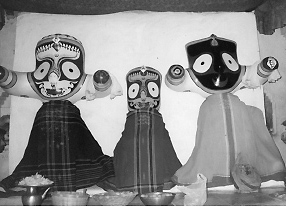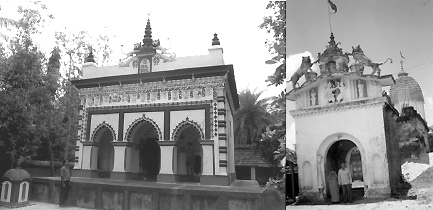Jagannatha Temples in Midnapore District
BY: SUN STAFF - 19.1 2022

Jagannath Temple Bahiri, East Medinapore
Gloom and Bloom: The Case of Jagannatha Temples in Midnapore District, by Prof. K. S. Behera.
The famous Jagannatha Temple of Puri, the main centre of the cult in Orissa, was plundered by Kalapahar, the trusted general of Sulaiman Karrani in 1568. It is said in the Madalapanji that he damaged the tower of Badadeula up to Amla. He also damaged all the Deities and tried to uproot the Kalpabata (sacred banyan). He took away Shri Jagannath Mahaprabhu from Puri to Tanda, located on the bank of the Ganga. There he put the Deity form into flame. A Quaji, however, disapproved his conduct of burning the Deity of Orissa, and for this Kalapahar's body was torn into pieces. In consequence he died.
His son floated the image (Deity) remnants down the Ganga. The daru (wood) was rescued by an Amura and thinking it to be a wooden log, he kept it in his field. When Jagannath Mahaprabhu was taken, one Bishara Mahanty followed Him. He went in the guise of a Vaishnava and he stayed for 8 months in the guise of a drummer. Requesting the Daru, he succeeded in getting the Brahma and placing it in a mrdanga, which he then brought to Kujangagarh. It was during the reign of Ramachandradeva that the Brahma was brought from Kujangagarh and the Deity images were made in Khurdha-kataka. Later on, in the 11th anka of Ramachandradeva, God Shri Purussotam was installed on the Ratnasinghasan of the badadeula. All the brahmans, sannyasis, and brahmacharis proclaimed Maharaja Shri Ramachandradeva as the II Indradyumna. [1]
The desecration of the Jagannath Temple of Puri is fairly corroborated by the Persian sources of the Afghan and Moghul period. The Afsanah-i-Shahan of Shaikh Kabir Batini is the earliest source which throws light on the Afghan conquest of Orissa. The important information in this text is that the original name of Kalapahar was Allahadad, and he belonged to the Batini Afghan clan. Mian Allahadad Kalapahar became a famous general of Sulaiman.
Karrani Kalapahar (Black Mountain) was a title given to a brave person during the Afghan period. During his conquest of Orissa, Kalapahar was informed "that a huge idol was hidden by people on the bank of the sea. He at once reached the place and caught hold of the idol, the eyes of which were studded with valuable pearls. Besides a big diamond formed its navel. Kalapahar got the idol broken in order to get the diamond undamaged. He also seized diamonds (from the Orissa nobles) along with other booty. The big diamond was given by him to his vakil, called Mian Kanaka, as a reward. It was considered by the jewellers as priceless for being matchless. Later on it was seized by (Raja) Man Singh who presented it to Akbar." [2]
Nimatlullah in his Makhzan-I-Afghan also refers to the desecration of the Jagannatha Temple. It is said by Niamat Ullah that [3] every Afghan who took part in the campaign obtained as booty one or two gold images. Kalapahara destroyed the temple of Jagannatha in Puri, which contained 700 idols made up of gold, the biggest of which weighed 30 mands. Abul Fazal also mentioned that Kalapahara, the general of Sulaiman, on his conquest of the country "flung the image of Jagannath into fire and burnt it and afterwards cast it into the sea."
Though there are conflicting accounts about the place where the image of Jagannath was burnt, the combined evidence of the Puri chronicle and the Persian sources makes it clear that there was no image of Jagannath on ratnavedi of the Temple due to the surprising raid of Kalapahar on the temple. Raja Mukunda Dev did his best to fight against the Afghans. In the battle, however, the Raja received a fatal injury as a result of the assault by his own nobles. Orissa ultimately came under the Afghan rule. Sulaiman left for Tanda, but Kalapahar remained in Orissa. Kalapahar died in western Orissa in 1570. Sulaiman Karrani died in 1572.

Lord Jagannatha, Baladev and Subhadra at Mohanpur temple, Medinapore
The re-establishment of Jagannatha at Puri was not possible during the time of Sulaiman Karrani and Kalapahar and exactly on which date the re-installment took place is still a matter of debate. According to the research of Herman Kulke, [4] the renewal of the cult at Puri could have been possible after Mansingh's treaty in 1590.
In 1590 the Afghans agreed to surrender the Temple of Jagannath and the sacred domains or the khetra to the Moghul Emperor. John Beams [5] observes," The Governor of Bengal at this time was Raja Man Singh, who as a Hindu, was highly pleased at rescuing the holy city from the hands of the infields who had long exercised a cruel and tyrannous sway over the priests."
In any case, the renewal of Jagannath cult under Ramachandra Dev of Khurdha was already completed before Raja Mansingh's pilgrimage to Puri in 1592. Thus it may be assumed that after Kalapahar's raids, the Ratnavedi was without its presiding Deities for about 22 years. This was a great psychological shock to the people of Orissa as Jagannatha is the symbol of Orissa's identity. During these critical years the atmosphere in Puri was filled with gloom. The later events, however, show that the setback was a temporary one and with re-installation of Jagannath at Puri, the glory of the cult was vindicated. The dark phase had ended.
In contrast, away from the center at Puri, in the peripheral region in the northern frontier, a Jagannatha temple came to be established in 1584 A.D. in Midnapore district of West Bengal. Midnapore came under the strong political and cultural influence of Orissa. When Sulaiman Karrani left with his army for Orissa and arrived near Midnapore, Raja Mukunda Dev went there to oppose him with 40,000 sawars, 4,000 elephants and innumerable foot soldiers. When news about the capture of Cuttack fort by Bayazid and Kalapahar reached him, he had to retreat for the defense of the Cuttack fort. In Midnapur District, the Jagannath Temple was erected in 1584 A.D.

Modern Jagannatha temple in Bahiri, East Medinapore (left) and Mohanapur Jagannatha temple in Medinapore (right)
One Vibhisan, the son of Padmanabha, dedicated a temple in honour of Jagannath at Deulbad, Bahirigrama, near Contai in Midnapore district. The inscription [6] mentions the installation of the images of Gopal, Rama (Balarama), Jagannath and Subhadra. The inscription engraved in Oriya script runs as follows:
1. Kasidasa-kule Vibhisana iti Sri Padmanabhatmajah Sriman= aviravud= acikarata sa prasadam=uccair=imam
2. Gopala-pratimam ca samyag=anaghaih sadbhih pratistham dvijai=Ramam c=eha Subhadraya saha Jaganatham nyadhasid=api
1. Pautrah Sri Dharanidharasya bhagavatsunor= dvijanm-agranih Sriman=Arjjuna Misraity=abhihitasy=acarya-cudamaneh
2. Putras=Cakradharah kavindra-iti yatnat sa pratistha-vidhim prasadasya Vibhisanasya vidhina krtva viramam gatah
The building of a lofty temple in honour of Jagannatha Trinity in the saka year 1506, i.e. 1584 A.D. is very significant when by that time, the renewal of Jagannatha at Puri had not taken place. The temple is of the rekha order, which resembles the Orissan temple style. It may be mentioned that the rekha and pidha style of Orissan temple exercised a profound influence in Midnapore and Bankura districts of West Bengal. The Sarvamangala temple at Kesiadi has Oriya inscriptions and the temple is of the pidha order. One Oriya inscription is dated in the saka year 1526, i.e. 1604 A.D., belonging to the time of Manasingh Maharaja. It appears that as a result of the tolerant policy of Akbar and Raja Mansingh (1590-1605), building activities continued in coastal Orissa.
Two inscriptions have been discovered from Srijang in Balasore district. One dated saka year 1517, i.e. 1595 A.D., refers to 34 anka of Gajapati Ramachandra Dev during Badasa Akbar and Mansingh. The inscription refers to the excavation of Achutasagar tank by Achuta Baliarsingh Mahapatra. Another inscription from the same place dated saka year 1520 (1598 A.D.) belongs to 37 anka of Ramachandra Dev of Khurdha. It refers to the excavation of lake Achutabanga by the same Baliarsingh Mahapatra.
A temple inscription found near Manjuri road refers to the 8th anka of Birashree Gajapati Goudeswar navakoti Karnata Kalabargeswar Shri Purussotam Maharaja. It also refers to arrival of Maharaja Mansingh and construction of deulamandapa of Sthaneswar Dev by the Jagirder of Manjuri called Jayamalla vidasha. The inscription also mentions sevakas such as Mali, sankhua, tahalia, mandapa khuntia, etc., and the use of high-sounding titles as Purussotam Deva of Khurdha Raj family sought to consolidate power to Suryavamsi Gajapati throne.
The inscriptions in coastal Orissa and the neighbouring Midinapore indicate that Orissa enjoyed peace, which provided the congenial atmosphere for building activities. Over the course of time, several Jagannath Temples came to be erected in Midnapore district.
The influence of the Jagannath cult was so strong that in Ramajee Temple in Mahisadal (built in 1788 A.D.), the image of Shri Ramachandra was replaced by Jagannath Trinity when the Ramachandra image was stolen. In Talakesiadi there is a Jagannatha Temple of the rekha order in which the wooden images of the Trinity Deities are worshipped. In place of Sudarshan, however, a small image of Jagannatha was worshipped as Sudarshan. In Orissa, Sudarshan resembles a stambha or a chakra, but here the Deity is represented by a small figure of Jagannath.
There is also a modern Jagannath temple at Bahirigam with wooden Deities of Lord Jagannath, Balabhadra and Subhadra. At Mohanpur in Midnapore district, about 15km from Jaleswar, there is a Jagannath temple which is in a ruined condition and requires preservation. The temple could have been built in the 18th century. In recent years a Jagannatha temple has been built at Kharagpur. A Jagannatha temple is also found at Dantan and in the village of Sonakania in the vicinity of Laxmannath.
Kedarnath Mohapatra, [7] in a small monograph, has mentioned several Jagannath temples in eastern India. In view of the importance of the subject and the spread of the cult to different parts of India, it is necessary to make a systematic survey of the temples in India and abroad, especially the medieval Jagannath temples in the Himalayan Hindu kingdom of Nepal.
References:
1. Madalapanji, A.B. Mahanty ed., Orissa Sahitya Akademi edition, 2004, pp.40-43.
2. For English translation of the extracts from Afsanah-I-Shahan, I.H. Siddiqui, Mughal Relations with the Indian Ruling Elite, New Delhi. 1983, p.157.
3. M.A. Rahim, History of the Afghans in India, Karachi, 1961, p.177f.
4. Eschmann, Kulke, Tripathi, ed. The Cult of Jagannath and the Regional tradition of Orissa, 1978, New Delhi, p.324f.
5. N.K. Sahu, A History of Orissa, Vol. II, New Delhi, 1980, p.298.
6. A.K. Bhattacharya, A Corpus of Dedicatory Inscriptions from Temples of West Bengal, Calcutta, 1982, p.54.
7. K.N. Mahapatra, The Jagannath Temples in Eastern India, Bhubaneswar 1977.
Prof. K.S. Behera is the Emeritus Fellow, Department of Ancient Indian History, Culture and Archeology, Utkal University, Bhubaneswar.






































